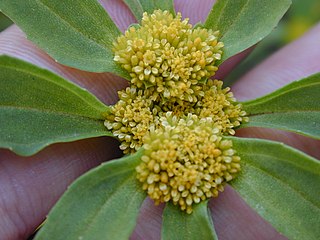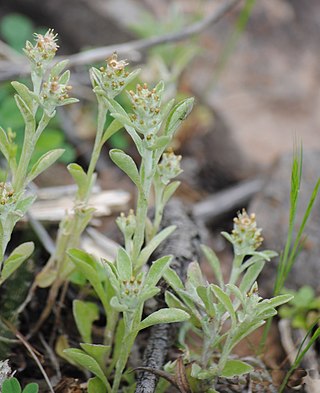
Gaillardia pulchella is a North American species of short-lived perennial or annual flowering plants in the sunflower family.

Coriaria is the sole genus in the family Coriariaceae, which was described by Linnaeus in 1753. It includes 14 species of small trees, shrubs and subshrubs, with a widespread but disjunct distribution across warm temperate regions of the world, occurring as far apart as the Mediterranean region, southern and eastern Asia, New Zealand, the Pacific Ocean islands, and Central and South America.

Coreopsis lanceolata, commonly known as lanceleaf coreopsis, lanceleaf tickseed, lance-leaved coreopsis, or sand coreopsis, is a North American species of tickseed in the family Asteraceae.

The small marsh flower Cotula coronopifolia bears the common names brass buttons, golden buttons, and buttonweed. The flower heads are bright yellow discoid heads that look like thick buttons. Individual plants spread stems along the ground and send up the knobby flowers at intervals. The plant is native to southern Africa, as well as New Zealand, but it has been introduced to other parts of the world.

Banksia grandis, commonly known as bull banksia or giant banksia, is a species of common and distinctive tree in the south-west of Western Australia. The Noongar peoples know the tree as beera, biara, boongura, gwangia, pira or peera. It has a fire-resistant main stem with thick bark, pinnatisect leaves with triangular side-lobes, pale yellow flowers and elliptical follicles in a large cone.

Sonchus asper, the prickly sow-thistle, rough milk thistle, spiny sowthistle, sharp-fringed sow thistle, or spiny-leaved sow thistle, is a widespread flowering plant in the tribe Cichorieae within the family Asteraceae.

Flaveria is a genus of plants in the family Asteraceae. They are sometimes called yellowtops. Some are annual or perennial herbs and some are shrubs. They bear yellow flowers in heads, with zero, one, or two ray florets in each head. These plants are found in the Americas, Asia, Africa, and Australia.

Bidens laevis is a species of flowering plant in the daisy family known by the common names larger bur-marigold and smooth beggarticks. It is native to South America, Mexico, and the southern and eastern United States. It grows in wetlands, including estuaries and riverbanks.

Flaveria trinervia is a species of flowering plant in the family Asteraceae known by the common names clustered yellowtops, speedyweed, and yellow twinstem. It is native to parts of the Americas, including the southeastern and southwestern United States, most of the Bahamas, Mexico, Belize, and parts of the Caribbean, especially Cuba, Cayman Islands, Jamaica, Hispaniola, Puerto Rico and Barbados. It is also known in many other places as an introduced species and often a noxious weed, such as in Hawaii.
Milleria is a genus of flowering plants in the tribe Millerieae within the family Asteraceae.
Flaveria chlorifolia, the clasping yellowtops, is a North American plant species of Flaveria within the family Asteraceae. It is native to the southwestern United States and northern Mexico.

Helianthus angustifolius is a species of sunflower known by the common name narrowleaf sunflower or swamp sunflower. It is native to the south-central and eastern United States, found in all the coastal states from Texas to Long Island, and inland as far as Missouri. It is typically found in the coastal plain habitat, particularly in wet areas.

Flaveria campestris, common name alkali yellowtops, is a plant species native to the southwestern United States and to the southern Great Plains. It is found on saline soils and on the margins of lakes, ponds and streams.

Arctotis venusta is a species of South African plants in the family Asteraceae. Common names include silver arctotis, kusgousblom, and blue-eyed African daisy. It is native to the western coast of South Africa, The species is widely cultivated as an ornamental, and has become naturalized in parts of the United States, Australia, and Central and South America, where it has escaped from gardens to become a noxious weed.

Bidens bipinnata is a common and widespread species of flowering plant in the family Asteraceae.
Flaveria brownii, or Brown's yellowtops, is a North American plant species of Flaveria within the family Asteraceae. It is found only in the coastal regions of southern Texas in the United States. It grows primarily in sand dunes and salt marshes.
Flaveria floridana, the Florida yellowtops, is a North American plant species of Flaveria within the family Asteraceae. It has been found only along the Gulf Coast of Florida between Clearwater and Marco Island, mostly in the Tampa Bay region.
Flaveria linearis, known as narrowleaf yellowtops, is a North American plant species of Flaveria within the family Asteraceae. It is native to Florida, Cuba, Bahamas, and the Yucatán Peninsula of Mexico.

Gamochaeta pensylvanica, the Pennsylvania cudweed or Pennsylvania everlasting, is a widespread species of flowering plant in the family Asteraceae. It is native to South America and introduced into Eurasia, Africa, Australia, and North America. The pensylvanica epithet is a misnomer, as the plant is not native to Pennsylvania and only marginally naturalized there.
Hypochaeris microcephala, the smallhead cat's ear, is a species of plants in the tribe Cichorieae within the family Asteraceae. It is native to South America and naturalized in parts of North America.














